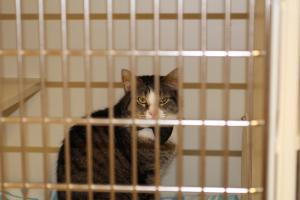A Blocked Cat is a Life Threatening Situation
- posted: Sep. 29, 2015

When Your Cat Can’t Pee
Male cats can sometimes develop a life-threatening problem called urethral obstruction, more commonly known as a “blocked cat.” What exactly does this mean? Some cats form crystals in their urine. These crystals can then combine with mucus to create a plug in the urethra which is the small tube that exits the bladder. This plug blocks urine output and the cat is unable to pee. Why is this a problem? If urine cannot be expelled, the kidneys cannot filter toxins and will start to fail. Failing kidneys lead to serious illness and even death. Urinary blockage is also extremely painful. If you have ever been stuck on the freeway after downing a Big Gulp with no bathroom in sight, you know how uncomfortable it is to have to urinate and not be able to go. Multiply that feeling by ten and that is how a blocked cat feels.
So, how do you know if your cat is blocked? A blocked cat will most likely be constantly going in and out of the litter box and trying to pee but not producing any urine or maybe only a few drops. The longer he is unable to pee, the more ill he will become. Blocked cats will strain in the litter box. They will become very lethargic and may even be lying in the litter pan. Some will vomit. If you ever see your mail cat straining in the litter box, call your vet immediately unless you are absolutely sure he is urinating. A blocked cat could be mistaken for a constipated cat thinking they are straining to poop rather than straining to urinate.
What should you do if you think your cat is blocked? CALL YOUR VETERINARIAN IMEDIATELY!!! If the plug in the urethra is not removed, your cat will die. It is a slow and painful death. No one wants to see this happen to their pet, and, the sooner you get help for the cat, the better the outcome will be.
What happens when your blocked cat goes to the vet? Your cat will be assessed and will most likely have some blood drawn to check his kidney function. The most important thing for a blocked cat is to re-establish urine flow. The way to do this is to sedate the cat and to pass a catheter through the urethra into the bladder to remove the plug. This will allow the cat to urinate again and to hopefully allow the kidneys to recover. Most cats are also given IV fluids once the obstruction is relieved. Cats usually spend 2-3 days in the hospital. The urinary catheter typically remains in place for 24 hours after which it is removed and we monitor your cat to make sure he is still able to urinate without the catheter.
What happens if he can’t pee once the catheter is removed? Sometimes, we can replace the catheter and keep it in a little longer, and things will be fine. In other cases, your cat may actually need a type of surgery to open the urethra making a wider opening so crystals and mucus are less likely to form a plug again. Most cats also need to eat a special diet to prevent or reduce crystal formation.
The chance of urinary obstruction can be reduced by reducing stress and providing toys and other environmental enrichment for your cat, making sure your cat is drinking enough water by using a cat fountain or other means of encouragement to drink and by feeding canned cat food.
This blog brought to you by the Patton Veterinary Hospital serving Red Lion, York and the surrounding areas. Questions or comments welcome on our website or Facebook page.
Location
Patton Veterinary Hospital
425 E Broadway
Red Lion, PA 17356
